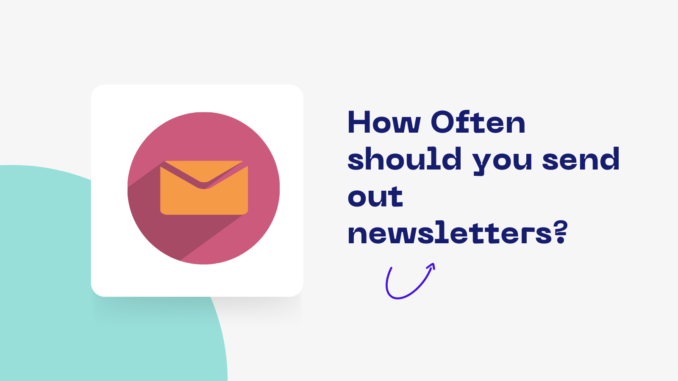
Timing is of big essence with regards to newsletters. With click-through rates as low as two percent for some companies, one of the ideal approaches to improve your results is by planning your emails and knowing how regularly to send them. But how often should you send newsletters?
As per studies, people loathe getting promotional emails except if they subscribed to the service, or the message has something “profitable” for them.
Decent email newsletter templates are out there to put you through. Nonetheless, one main consideration that affects how someone feels about getting a message is timing.
Email Frequency
Gradually increasing the frequency of your emails requires you be aware of your audience. This is another way to say, pay attention.
The Number one reason people unsubscribe from your messages is that they receive them way too often from only one sender. A subscriber who opts out of your newsletter may likewise report you as a spammer, to disengage; people who opt out have been seen as trolls, and some put withering reviews and comments.
Another result of over-sending your emails is that it will cause a decrease in your open and click-through rates. With a little keenness, you can bypass all of this.
A surefire approach to abstain from oversharing is always to plan your list by explicit parameters and tailor your emails to the targeted subscribers based on those parameters.
The actual success or failure of your newsletter campaign is anything but difficult to decide. It is in your data.
Also called hiding in plain sight. Some people pay agencies or vendors to make their newsletter marketing campaign; however, for those who are not, you should be looking at the data.
Stuff like the open rates, conversions, click-through rates, and some other data points germane toward your marketing objectives.
Any decent newsletter tool will have these sorts of data analytic or tracking abilities built-in. The better ones will produce real-time reports and have easy-to-read dashboards for speedy reference.
What should you do?
Once you start answering the critical questions, then you may have a few worries about how frequently you will be able to keep up with your newsletters.
If you are a Constant Contact client, there are various tools you can use to make the most of your time. For frequently-scheduled emails — like weekly newsletters or monthly updates — create newsletters templates to avoid having to begin from scratch.
If you have a specific time or day that you commit to completing your marketing tasks, you can make your newsletters early and schedule them to send ahead of time.
Tips to Make your Email Marketing Successful
For new readers who may require more info about your brand, use Autoresponder to set up a progression of automated messages which can be forwarded on their own. As you try different sending frequencies, try to follow your results by checking your email reports.
A powerful email cadence has the power to boost customers and apparently revenue. You will be stunned to know that by spending more and more email an insurance company increased revenue by 45%. While an eCommerce store’s revenue slumped by 30% after lowering the frequency of the email newsletter.
1. Focus on Customer Life cycle
As per the reports of Zettasphere, email frequency sends sweet spot is 6.21 emails per week and if you are in the fashion, one can send close to 6 emails per week.
However, diverse brands and verticals may have different optimal values for how often to send. In simpler words, types of customers hold prominence in driving the email marketing frequency.
Like a fashion brand should send 6.21 emails per week and clothing have a fast repeat purchase cadence and numerous people regardless of age and gender take fashion VERY seriously. While, when we talk about a SaaS company, sending 6.21 emails times per week would be futile. Occasional email marketing would do the work.
2. Know your Email Goals
Try to dodge the changes of email frequency before knowing the sole purpose of your email marketing. Before knowing the answers to how often should you initiate email marketing, you should start by interviewing yourself. Why do I need to send emails in the first place? Is the plan to lure more online purchases? Boost goodwill? Brand awareness? Close deals? Customer analysis? Drive website audience? Commence a new product or service? All of the above?
If the ultimate goal is to drive web traffic, online revenue or purchases, you should focus on risking a few unsubscribes for higher numbers. However, if your reader is your sales lead, then you shouldn’t clog up their inboxes with an abundance of marketing emails.
3. Look for the Spam
No matter how good your creative is, it is indeed futile if it doesn’t reach the target customer’s inboxes. According to EveryAction, 24.16% of emails sent by nonprofit organizations went to spam in 2017 meaning a 24.16% loss of possible fundraising revenue.
While Return Path in its research found that over 20% of commercial email never reach the inbox. What is more surprising that the senders with the worst reputations, less than 1% of their emails see delivered status.
Therefore, it is important to cast a gimlet eye on the engagement metrics and take instant actions if you witness a decrease in clicks or an uptick in unsubscribes bounces.
4. Set Expectations Early of the Customers
Many subscribers get irritated when they don’t get what they were looking for. Therefore, it is necessary to tell your subscribers to know from the beginning what they are actually signing up for.
For instance, if you are planning to send emails on a regular basis, then let your customers know that they are signing up for DAILY emails.
Marketing Sherpa concurred and revealed that in a report conducted by them found that over 80% of customers expect monthly emails while less than 20% want daily emails. The abundance of email is the top reason why many people unsubscribe for a brand.
The ideal solution is to segment your audience by engagement level, otherwise, you’ll have to weigh the benefits of more frequent communication with the increased unsubscribes.
Conclusion
Discovering the right email frequency can bring about higher open rates, fewer unsubscribers, and more chances to do more business with newsletter campaigns. Begin monitoring your email reports. They will tell you how your present email frequency is working for your brand.

Leave a Reply